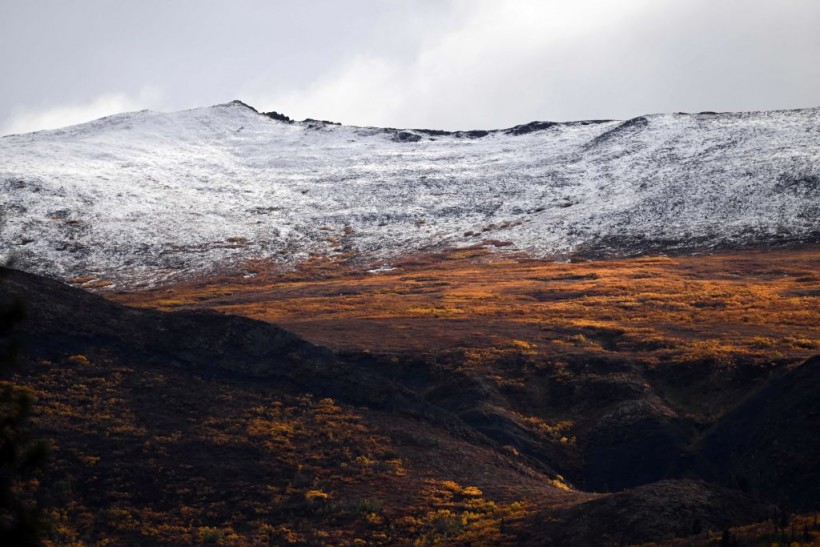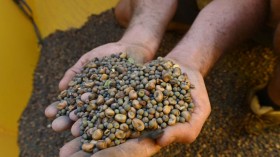Denali National Park and Preserve is a vast wilderness area in Alaska, home to diverse wildlife and stunning scenery.
It is also a treasure trove of dinosaur fossils, as scientists have discovered over the years.
The Coliseum is a massive cliff that contains layer upon layer of dinosaur prints preserved in rock, spanning a period of several million years.
The site revealed the diversity and abundance of dinosaurs that lived in what is now Interior Alaska during the Late Cretaceous Period, about 70 million years ago.
How was The Coliseum discovered and documented?
 (Photo : PATRICK T. FALLON/AFP via Getty Images)
(Photo : PATRICK T. FALLON/AFP via Getty Images)

The Coliseum was discovered by a team of researchers from the University of Alaska Fairbanks, who have been studying dinosaur tracks in Denali National Park since 2006.
The site is located in a remote area of the park, accessible only by hiking for several hours or by helicopter.
The researchers first visited the site in 2016, but they did not realize its full extent until they returned in 2018 with better equipment and lighting conditions.
The site consists of a layered, rocky outcrop that rises about 20 stories from its base.
The outcrop was once a flat sedimentary deposit near a watering hole on a large floodplain, where dinosaurs left their footprints as they walked or rested.
Over time, the sediment hardened into rock and was tilted vertically by tectonic forces that formed the Alaska Range.
This exposed the layers of tracks on the cliff face, creating a spectacular display of dinosaur history.
The researchers used various methods to document and analyze the tracks at The Coliseum. They used drones to take aerial photos and videos of the site, which they stitched together to create a high-resolution map of the tracks.
They also used photogrammetry to create 3D models of individual tracks, which they measured and identified using a database of known dinosaur footprints.
They also collected rock samples from the site, which they examined for fossilized plants, pollen grains, and freshwater shellfish and invertebrates.
The researchers found that The Coliseum contains thousands of tracks from at least six different types of dinosaurs, including hadrosaurs (duck-billed herbivores), ceratopsians (horned herbivores), ankylosaurs (armored herbivores), therizinosaurs (clawed herbivores), ornithomimids (ostrich-like omnivores), and tyrannosaurs (large carnivores).
The tracks are arranged in multiple layers, each representing a snapshot of dinosaur activity at different times.
Some layers contain more tracks than others, suggesting variations in dinosaur abundance and diversity over time.
Also Read: Ancient Rats May Have Eaten Dinosaurs, Scientists Say
What does The Coliseum tell us about dinosaurs in Alaska?
The Coliseum is not only the largest known single dinosaur track site in Alaska, but also one of the largest in the world.
It provides a unique window into the life and behavior of dinosaurs in high-latitude environments, which are poorly understood compared to lower-latitude regions.
One of the main questions that The Coliseum helps to answer is how dinosaurs coped with the seasonal changes in light and temperature that occurred in Alaska during the Late Cretaceous Period.
Alaska was located about 10 degrees farther north than it is today, meaning that it experienced long periods of darkness and cold in winter and long periods of light and warmth in summer.
These conditions could have affected the availability and quality of food and water for dinosaurs, as well as their metabolism and activity patterns.
The researchers found evidence that dinosaurs were active throughout the year at The Coliseum, as they detected tracks from all seasons based on the fossilized plants and pollen grains associated with them.
This suggested that dinosaurs were able to adapt to the harsh winter conditions by either migrating to lower latitudes or hibernating underground or under snow.
Alternatively, dinosaurs may have had physiological adaptations that allowed them to maintain their body temperature and energy levels during winter, such as feathers or fat reserves.
Another question that The Coliseum helped to answer is how dinosaurs interacted with each other and their environment at The Coliseum.
The site offered clues about the social behavior, feeding habits, and predator-prey relationships of dinosaurs in Alaska.
The researchers found evidence that some dinosaurs traveled in groups or herds at The Coliseum, as they observed parallel or overlapping trackways from multiple individuals of the same species.
This suggested that dinosaurs may have benefited from social cohesion and cooperation for protection, communication, or reproduction.
For example, hadrosaurs may have formed large herds to defend themselves from predators, while ceratopsians may have formed smaller groups to display their horns and frills to potential mates.
The researchers also found evidence that some dinosaurs fed on plants or animals at The Coliseum, as they observed bite marks, coprolites (fossilized feces), and gastroliths (stones swallowed to aid digestion) associated with the tracks.
This suggested that dinosaurs had diverse and specialized diets that reflected their adaptations and preferences.
For example, therizinosaurs may have fed on ferns and horsetails, while tyrannosaurs may have fed on hadrosaurs or ceratopsians.
The researchers also found evidence that some dinosaurs avoided or confronted each other at The Coliseum, as they observed trackways that showed signs of avoidance or confrontation.
This suggested that dinosaurs had complex and dynamic interactions that involved competition, predation, or mutualism.
Related article: Were Dinosaurs Killed by Volcanoes? Recent Study Disagrees
© 2024 NatureWorldNews.com All rights reserved. Do not reproduce without permission.





